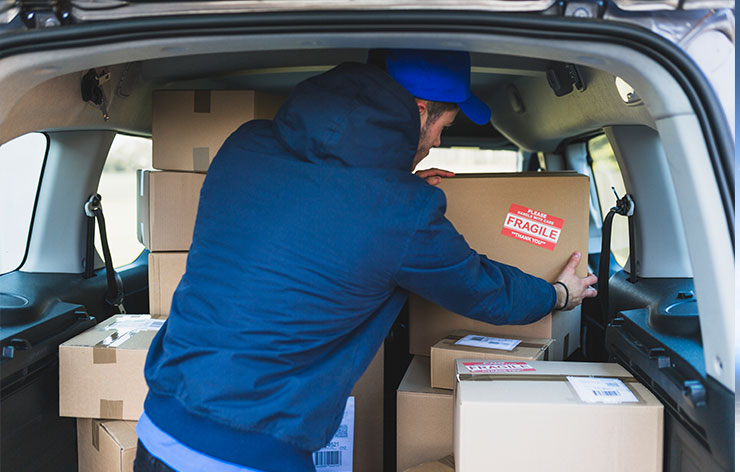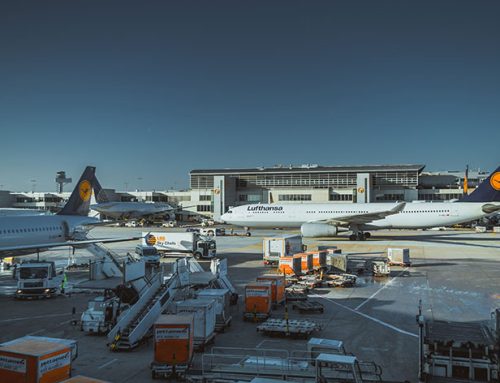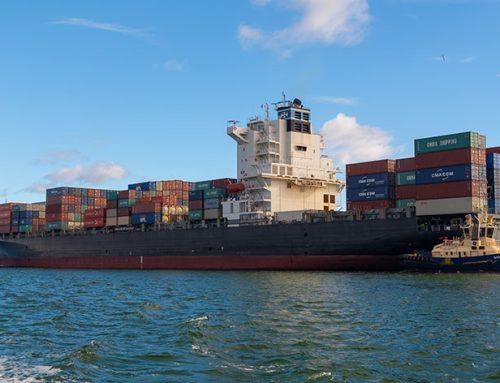DPU – Delivered at Place Unloaded
Definition of DPU – Delivered at Place Unloaded
In Incoterms 2010, this rule was referred to as “DAT – Delivered At Terminal”
DAT itself was introduced 2010 as an expansion of DEQ (Delivered Ex Quay) to cover any mode of transport. The implication in DAT was that the seller delivered the goods, unloaded, into a terminal whether that be an open area of land such as a container yard or a covered warehouse such as at an airport. Regrettably that explanation was not clear in the wording of DAT though its location before DAP in the order of the 2010 rules tends to reinforce that. The difference now between DPU and DAP is that it means any place including the buyer’s premises and therefore is shown now after DAP.
So, DPU is a new rule for 2020 and while it is often stated as simply being a change of name from the previous DAT (Delivered At Terminal) it is in fact just that little bit more.
There are no restrictions on the named place – for example it can be a transport hub, a warehouse or the buyer’s depot.
The seller is responsible for arranging carriage and for delivering the goods, unloaded from the arriving means of transport, at the named place.
Risk transfers from seller to buyer when the goods have been unloaded. This is the only rule that requires the seller to unload the goods in order to complete delivery. The buyer is responsible for import clearance and any applicable local taxes or import duties.
A useful rule, well suited to container operations where the seller bears responsibility for the main carriage.
In short: For DPU (Delivered at Place Unloaded) shipping, the seller arranges all export country charges and international transit. The buyer arranges the rest.
DPU Incoterm Buyer & Seller Obligations
Seller’s Obligations
- Goods, commercial invoice and documentation
- Export packaging and marking
- Export licenses and customs formalities
- Pre-carriage and delivery
- Loading charges
- Main carriage
- Delivery at named place of destination
- Unloading charges
- Proof of delivery
- Cost of pre-shipment inspection
Buyer’s Obligations
- Payment for goods as specified in sales contract
- Import formalities and duties
- Cost of import clearance pre-shipment inspection
- Onward carriage and delivery to buyer (depending upon named place)
Where Is The Named Place For Handing Over Responsibility From The Seller To The Buyer?
The seller continues responsibility and risk into the import country, up until the shipment is unloaded. This can occur at a number of locations, including the port, inland terminal, or forwarder’s warehouse.
DPU (Delivered at Place Unloaded) is for which type of cargo?
The ICC has divided the 11 Incoterms into those that can be used for any mode of transportation and those that should only be used for transport by “sea and inland waterway.” Under Incoterms 2020, DPU can be used for any mode of transportation.
Certainly for land transport within the Europe/Central Asian land mass it is feasible, and with courier parcels delivery it represents what typically happens as the driver takes the parcel from the truck and hands it to the buyer. It is even feasible for smaller airfreight parcels which the truck driver can lift.
How it will turn out in practice for heavier packages by airfreight and cross-ocean container shipments is yet to be seen. Not only must the seller’s carrier obtain from the buyer the appropriate paper work to take possession of the goods from the airline or shipping line but now it must also provide the means of unloading the truck at the destination place. For a container this could mean providing additional labour and a forklift plus a pallet jack for moving the goods within the container. Add to that potential insurance and workplace safety issues when labour and machinery not employed or contracted by the buyer operate within the buyer’s premises.
DPU: Worth noting
The DPU term is often used for consolidated containers with multiple consignees, and it is the only term that tasks the seller with unloading the goods. This is because if a delivery has multiple consignees, the seller can break down the shipment to make the goods available for them. Also, if items require additional or special handling, the seller agrees to be responsible for, they should select this term.
With DPU, sellers should be sure they have engaged someone at the destination to handle the goods to unload them. If they don’t want to be responsible for this step, they should use the DAP instead.
This rule favors the seller where the seller is stronger, being liable and responsible for all tasks in the export country; and favors the buyer where the buyer is stronger, being liable and responsible for all tasks in the import country. The seller is also liable and responsible for the main freight. Also consider DAP with a terminal as the named place, where the buyer pays for unloading.
Advantages and Disadvantages of DPU – Delivered at Place Unloaded
As stated previoulsy, this rule started out life in 1953 as EXQ (Ex Quay) and was renamed in Incoterms® 1990 as DEQ (Delivered Ex Quay), requiring the seller to deliver the goods unloaded from the vessel onto the quay (wharf). Clearly this referred only to goods directly loaded onto the vessel such as bulk and break-bulk cargo. In Incoterms® 2010 this rule was replaced by an expanded one to cover any mode of transport, DAT (Delivered at Terminal) where a “terminal” was described in the Guidance Note (as “information that is particularly helpful” according to the Introduction in that book) but not in the rule itself, as including “any place, whether covered or not, such as a quay, warehouse, container yard or road, rail or air cargo terminal.” Clearly it was envisaged that it referred to delivery into some form of transport terminal for the buyer to collect them, after any import clearance formalities had been completed.
Fairly late in discussions for the Incoterms® 2020 rules there were representations from a very small number of National Committees to expand this rule to cover delivery to the destination outside a terminal and where the seller arranged unloading. This could occur for example with specialised capital machinery being delivered to a site where the seller was also responsible for assembly and installation. Thus, at almost the last minute, was borne DPU (Delivered at Place Unloaded). When the Drafting Committee revised DAT to DPU it received support from an increased number of National Committees.
This rule differs from DAP in only one point, that in DAP the seller delivers at the nominated place not unloaded and in DPU unloaded.
DPU (Delivered at Place Unloaded) and insurance
In the case of DPU Incoterms, there is no obligation to make a contract of insurance.
DPU (Delivered at Place Unloaded) and Letters of Credit
DPU transactions are largely incompatible with payment by the typical letter of credit. With delivery only occurring at the very end of the transport chain, an LC calling for presentation of say a bill of lading consigned to order and blank endorsed would be a contradiction to DPU. Even more so if the issuing bank was of the habit of requiring bills of lading consigned to their order which they then endorse to their applicant (the buyer) so the buyer can take hold of the goods. There is nothing to secure the seller’s position of the buyer not taking hold of the goods until the issuing bank has honoured the drawing under the LC as, after all, the seller’s truck is sitting in the buyer’s nominated delivery place merely waiting for unloading. Imagine how totally strange it would be for the seller to arrive at the buyer’s receiving dock, obtain some form of delivery receipt from the buyer, send it back to their office overseas, present it to their bank who sends it to the issuing bank who hopefully honours the presentation. In the meanwhile, the truck is sitting blocking the receiving dock for a couple of weeks with the driver having set up camp in the truck’s cabin until his office back home tells him they have received payment and he can now let the buyer unload!
Differences between DPU and DAP (Delivered at Place)
In DPU Incoterms, the seller should ensure that he can organize unloading at the named place. If the parties intend the seller not to bear the risk and cost of unloading, it is recommended to avoid the DPU rule and use a DAP (Delivered at Place) instead.
The Incoterm DPU is the only Incoterm in which the goods are delivered unloaded at the destination. In turn, the only difference between DPU and DAP is that while in DPU the goods are delivered unloaded and in DAP are delivered ready for unloading.
DPU Tips And Tricks
- The seller pays for unloading. The buyer is responsible for all charges after unloading, except (in theory) any charges caused by delay, including demurrage charges at the terminal, which is generally the seller’s responsibility.
- That exception can get contentious. The seller has good grounds to refuse to pay if the buyer held up import customs clearance. But, maybe that was because the seller submitted incorrectly in the first place. Maybe that was the Customs broker’s error. Consider ways to avoid this type of dispute when negotiating the contract, stage, e.g. the seller couriers some documents to the buyer before pickup; liability for demurrage and other costs takes into account the above scenario, all information on documents to be submitted to Customs must be double-checked. Basically, the buyer, seller, and carrier need to work closely. Or instead, consider CPT (delivery to buyer’s warehouse).
- Ensure that the seller can undertake all the necessary formalities in the buyer’s country, e.g. paying GST or VAT.
- Damages are more likely to occur between the buyer’s premises and the import country terminal than the final leg to the buyer’s warehouse. However, this can be difficult to prove. Consider DAP instead.
- If the named place is a clearance depot, or for more porous borders where Customs does pre-clearance at the border, the shipment may be delivered to the named place uncleared. That is, payment to Customs is still required.





Leave A Comment